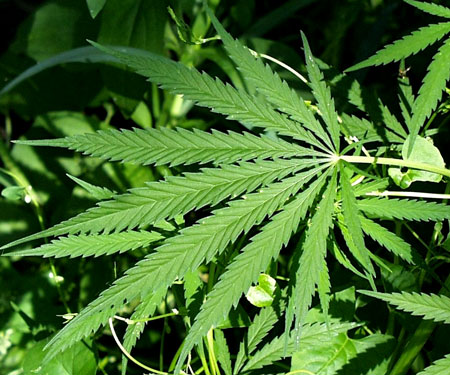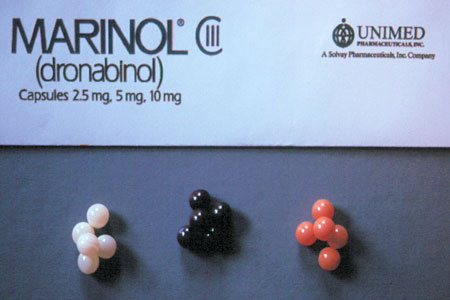Cannabis has been grown and used for centuries as food, medication, fuel, fiber, shelter—as well as an intoxicant. When the plant is grown for its fiber and pulp it is called “hemp” and the crop is densely sown. When it is grown for its leaves and buds it is called “cannabis,” and the plants are sown more sparsely.
Unique to the cannabis plant is a group of chemicals called cannabinoids (or phytocannabinoids). Approximately one hundred different cannabinoids have been identified in cannabis. Delta-9-tetrahydrocannabinol (THC) is the primary psychoactive cannabinoid, and the THC content is often used to differentiate hemp from cannabis. Hemp plants generally have a THC content of <0.3%, while the medicinal cannabis plant has >1% THC content.
Cannabis is a fast-growing and sun-loving dioecious plant (meaning that the seeds will grow into male or female plants). When grown for its medical or psychoactive effects, the males are separated from the females and destroyed as soon as they can be identified, to avoid fertilization. Without fertilization, the female plant, referred to as sinsemilla (without seed), will focus its energy on producing flowers and resin. The primary source of the active cannabinoids is found in the leaves and flowers or, more specifically, in the glandular trichomes found on the vegetative material. These trichomes hold the sticky resin that is used to make hash oil. The cannabinoids are fat-soluble (lipophilic) rather than water-soluble (Martin et al., 2011).
Cannabis Plant Showing Trichomes

The trichomes are the primary source of the active cannabinoids. Source: Courtesy of Ethan Russo. Used by permission.
There have been several species of the genus Cannabis, but in general Cannabis sativa and Cannabis indica are the most widely recognized. The sativa plant generally is taller with longer branches and slender palmate leaves, while the indica is more compact with shorter branches and broader palmate leaves. The sativas generally produce a more psychoactive stimulating effect, while the indicas produce a more sedating or relaxing effect. Today’s growers have developed numerous strains combining genetics from indicas and sativas to produce new varieties.
Cannabis Sativa

Source: Wikipedia Commons. Originally from the U.S. Fish and Wildlife Service.
The Phytocannabinoids
While modern medicine and our pharmaceutical industry may continue to focus on specific chemicals in medical cannabis, others believe that the natural botanical with all of its constituents may be safer and more beneficial. When using the whole plant, these chemicals work together in a synergistic manner that provides more therapeutic benefits to the patient and usually fewer or milder side effects. In addition to the cannabinoids, cannabis also contains terpenoids and flavinoids that have therapeutic value (McPartland & Russo, 2001).
As stated earlier, delta-9-THC is the primary psychoactive cannabinoid found in the cannabis plant, but researchers have identified close to one hundred phytocannabinoids. The array of cannabinoids in the plant varies among its diverse strains. Most of the research on cannabis has been conducted on THC rather than the whole plant or its other cannabinoids. However, much has been learned about the pharmacologic actions of some of the other nonpsychoactive cannabinoids.
Cannabidiol (CBD) is a very promising cannabinoid that has a wide range of effects including anti-emetic, analgesic, anti-inflammatory, anxiolytic, neuroprotective, antipsychotic, anticancer, and bone stimulation. In addition, in Brazil, two research laboratories have been evaluating the use of CBD for anxiety, depression, bipolar disorder, psychosis, and post traumatic stress (Takahashi, 2010; Crippa, 2010).
Other cannabinoids of interest include cannabinol (CBN), cannabichromene (CBC), delta-8-THC, cannabigerol (CBG), and tetrahydocannabivarin (THCA) (Izzo et al., 2009). Cannabinol has sedative and antibiotic properties and, as a degradation product of THC, the amount of cannabinol increases as the plant material ages. Cannabichromene and CBG are noted for their anti-inflammatory, antibiotic, and antifungal properties. Delta-8-THC lacks the psychoactive properties of delta-9-THC but serves as an effective anti-emetic (Plasse, 2002).
In an Israeli study on eight pediatric oncology patients, delta-8-THC was uniformly effective in the management of chemotherapy-induced nausea and vomiting (Abrahamov et al., 1995). In fact, since October 2003 the U.S. government has held a patent (#6630507) on cannabinoids as anti-oxidants and neuroprotectants (Hampson et al., 2003).
Terpenoids are responsible for the distinctive smell of cannabis and are easily extracted as an essential oil. Although terpenoids are found in other plants, there are more than one hundred terpenoid compounds found in cannabis. Terpenoids also produce therapeutic effects including anti-inflammatory, antibiotic, antineoplastic, antimalarial, and antiviral. Approximately twenty flavinoids are found in cannabis and they provide additional therapeutic effects including anti-inflammatory, antiviral, and anxiolytic (McPartland & Russo, 2001).
Marinol vs. Cannabis
Marinol is synthetic THC in sesame oil and comes in capsules at doses of 2.5, 5, and 10 mg. In 1986 Marinol (dronabinol) was released as a new Schedule II medication and marketed as the pharmaceutical equivalent to cannabis. Dronabinol, developed by Roxanne Laboratories, was supposed to end the fight for medical marijuana because a “marijuana pill” was now available. It was initially allowed by prescription for chemotherapy-induced nausea and vomiting and later authorized as an appetite stimulant. After several years on the market and with no diversion problems, it was down-regulated* to Schedule III in 1999. In 2010 the patent expired for dronabinol and the DEA/FDA now allows both natural and synthetic forms of THC as legal medication in Schedule III.
*To date, dronabinol is the only drug ever down-regulated in the controlled substances scheduling classification. Many drugs have been rescheduled to a more restrictive category, but this was the first time a drug was moved to a less restrictive level.
Marinol Capsules Shown in Three Doses

Marinol is synthetic THC in sesame oil. Source: Courtesy of Ethan Russo. Used by permission.
The assignment of synthetic THC (Marinol) to Schedule III is not reasonable in light of cannabis’s assignment to Schedule I. The DEA/FDA allows the use of the primary psychoactive substance in cannabis (the substance that produces the “high”) in pill form, yet continues to prohibit the whole plant. The federal government complains that marijuana is much stronger today than decades ago; what they mean is that the THC content in the plant is higher. Strong strains of cannabis may be up to 20% THC, yet dronabinol is 100% synthetic THC in sesame oil.
As noted above, there are other nonpsychoactive cannabinoids found in whole cannabis. When CBD is present in cannabis, it dampens the psychoactive effects of THC; so, even if an individual used a strain with 20% THC, the CBD would interact with the THC to decrease the psychoactive effects. Patients report that cannabis works better for them than dronabinol. Many report dysphoria (feeling unwell or unhappy) with dronabinol (Holland, 2010).
FDA-Approved Forms
To date, FDA has approved one cannabis-derived and three cannabis-related drugs, which are only available with a prescription from a licensed healthcare provider. FDA has approved Epidiolex, which contains a purified form of CBD for the treatment of seizures associated with Lennox-Gastaut syndrome or Dravet syndrome in patients 2 or older. FDA has concluded that Epidiolex is safe and effective for its intended use.
FDA also has approved Marinol and Syndros for therapeutic uses in the United States, including for the treatment of anorexia associated with weight loss in AIDS patients. Marinol and Syndros include the active ingredient dronabinol, a synthetic delta-9- tetrahydrocannabinol (THC) which is considered the psychoactive component of cannabis. Another FDA-approved drug, Cesamet, contains the active ingredient nabilone, which is chemically similar to THC and synthetically derived (FDA, 2019).
